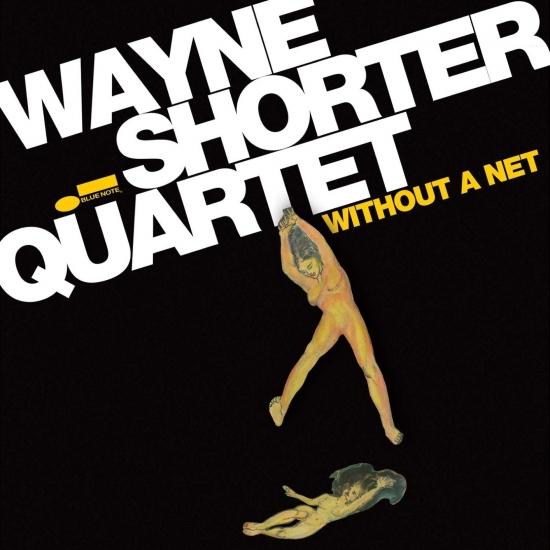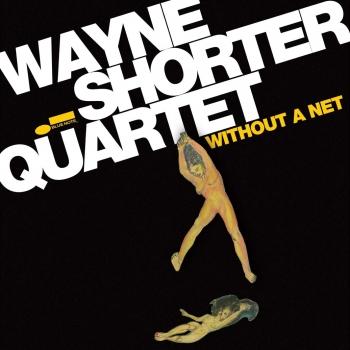
Without A Net Wayne Shorter
Album info
Album-Release:
2013
HRA-Release:
02.01.2018
Album including Album cover
I`m sorry!
Dear HIGHRESAUDIO Visitor,
due to territorial constraints and also different releases dates in each country you currently can`t purchase this album. We are updating our release dates twice a week. So, please feel free to check from time-to-time, if the album is available for your country.
We suggest, that you bookmark the album and use our Short List function.
Thank you for your understanding and patience.
Yours sincerely, HIGHRESAUDIO
- 1Orbits04:49
- 2Starry Night08:48
- 3S.S. Golden Mean05:17
- 4Plaza Real06:56
- 5Myrrh03:03
- 6Pegasus23:06
- 7Flying Down To Rio12:44
- 8Zero Gravity to the 10th Power08:13
- 9(The Notes) Unidentified Flying Objects04:12
Info for Without A Net
Without A Net marks the legendary jazz saxophonist and composer Wayne Shorter return to Blue Note Records for his first album as a leader for the iconic label in 43 years. The album which features his long-running Quartet with pianist Danilo Perez, bassist John Patitucci, and drummer Brian Blade is a 9-track musical thrill ride that consists of live recordings from the Quartet s European tour in late 2011, the one exception being the 23-minute tone poem Pegasus which features the quartet with The Imani Winds recorded at Walt Disney Concert Hall in Los Angeles. The album features six new Shorter compositions, as well as new versions of his tunes Orbits (from Miles Davis Miles Smiles album) and Plaza Real (from the Weather Report album Procession). The quartet also reinvents the title song from the 1933 musical film Flying Down To Rio, which film buffs (such as Shorter) know as the first on-screen pairing of Fred Astaire and Ginger Rogers.
"A band of spellbinding intuition, with an absolute commitment to the spirit of discovery, it has had an incalculable influence on the practice of jazz in the 21st century." (New York Times)
"Without a Net is not just a new high watermark for Shorter and his stellar quartet, it's a truly masterful masterpiece to add to a discography already brimming with classic recordings that will further cement Shorter's inscription and, as it evolves, his quartet's as well in the rarefied upper echelon of jazz history." (AllAboutJazz)
"Without a Net is Wayne Shorter's first Blue Note recording date since August 26, 1970, when he recorded Moto Grosso Feio and Odyssey of Iska. That's nearly 43 years. Shorter has pursued many paths since then, as a member of Weather Report, and as a bandleader. This quartet was assembled for a 2001 European tour and has been playing together ever since. It shows. The interplay Shorter shares with pianist Danilo Pérez, bassist John Pattitucci, and drummer Brian Blade is not merely intuitive, it is seamlessly empathic. All but one of these tunes were recorded during the group's 2011 tour. The lone exception is "Pegasus," recorded with the Imani Winds at the Walt Disney Concert Hall. There are six new tunes here; the quartet is credited with two of them. Shorter also revises some others, including set opener "Orbits" (the original was on Miles Davis' Miles Smiles) and "Plaza Real" (from Weather Report's Procession album). The only outlier, "Flying Down to Rio," is a version of the title tune from a 1933 film. Fireworks from this band can be heard everywhere. But the group aesthetic is especially noticeable in the penetrating romanticism of "Starry Night," where what appears restrained -- at least initially -- is actually quite exploratory and forceful. It's also apparent in the slow deliberation at play in the brooding "Myrrh." "Plaza Real" is a different animal here. Shorter's soprano soars and swoops through the melody, extending it at each turn as Pérez offers bright, pulsing chords to highlight the harmonic richness on display. Blade digs deep into his tom-toms, and finds an alternate polyrhythmic route that underscores the elegance and momentum in Shorter's lyric invention. The album's centerpiece is the 23-minute "Pegasus," which expands the band into a nonet. It is a tone poem that commences very slowly and deliberately. But its form gradually opens to allow for great expressions of individual and group freedom. Shorter's athletic soprano solo is breathtaking. The arrangement on "Flying Down to Rio" turns its catchy yet off-kilter melody into a group dialogue centered around a swirling series of complex harmonic statements. Pattitucci introduces "Zero Gravity to the 10th Power" with a funky vamp before layers of melody, harmonic extrapolation, and rhythmic interplay are added. By the time Shorter takes his tenor solo, we've heard everything from Latin grooves to modal assertions to classical motifs and some near explosions from Blade. While any new album from Shorter is an event at this juncture (he's nearly 80 yet in peak form here as composer and soloist), Without a Net is special even among the recordings made by this outstanding group." (Thom Jurek, AMG)
Wayne Shorter, tenor saxophone, soprano saxophone
John Patitucci, bass
Brian Blade, drums
Danilo Perez, piano
Recorded 8 December 2010 at Walt Disney Concert Hall ("Pegasus" only)
Produced by Wayne Shorter
 Wayne Shorter
Wayne Shorter
Though some will argue about whether Wayne Shorter's primary impact on jazz has been as a composer or as a saxophonist, hardly anyone will dispute his overall importance as one of jazz's leading figures over a long span of time. Though indebted to a great extent to John Coltrane, with whom he practiced in the mid-'50s while still an undergraduate, Shorter eventually developed his own more succinct manner on tenor sax, retaining the tough tone quality and intensity and, in later years, adding an element of funk. On soprano, Shorter is almost another player entirely, his lovely tone shining like a light beam, his sensibilities attuned more to lyrical thoughts, his choice of notes becoming more spare as his career unfolded. Shorter's influence as a player, stemming mainly from his achievements in the 1960s and '70s, has been tremendous upon the neo-bop brigade who emerged in the early '80s, most notably Branford Marsalis. As a composer, he is best known for carefully conceived, complex, long-limbed, endlessly winding tunes, many of which have become jazz standards yet have spawned few imitators.
Shorter started on the clarinet at 16 but switched to tenor sax before entering New York University in 1952. After graduating with a BME in 1956, he played with Horace Silver for a short time until he was drafted into the Army for two years. Once out of the service, he joined Maynard Ferguson's band, meeting Ferguson's pianist Joe Zawinul in the process. The following year (1959), Shorter joined Art Blakey's Jazz Messengers, where he remained until 1963, eventually becoming the band's music director. During the Blakey period, Shorter also made his debut on records as a leader, cutting several albums for Chicago's Vee-Jay label. After a few prior attempts to hire him away from Blakey, Miles Davis finally convinced Shorter to join his Quintet in September 1964, thus completing the lineup of a group whose biggest impact would leap-frog a generation into the '80s.
Staying with Miles until 1970, Shorter became at times the band's most prolific composer, contributing tunes like 'E.S.P.,' 'Pinocchio,' 'Nefertiti,' 'Sanctuary,' 'Footprints,' 'Fall' and the signature description of Miles, 'Prince of Darkness.' While playing through Miles' transition from loose post-bop acoustic jazz into electronic jazz-rock, Shorter also took up the soprano in late 1968, an instrument which turned out to be more suited to riding above the new electronic timbres than the tenor. As a prolific solo artist for Blue Note during this period, Shorter expanded his palette from hard bop almost into the atonal avant-garde, with fascinating excursions into jazz/rock territory toward the turn of the decade.
In November 1970, Shorter teamed up with old cohort Joe Zawinul and Miroslav Vitous to form Weather Report, where after a fierce start, Shorter's playing grew mellower, pithier, more consciously melodic, and gradually more subservient to Zawinul's concepts. By now, he was playing mostly on soprano, though the tenor would re-emerge more toward the end of WR's run. Shorter's solo ambitions were mostly on hold during the WR days, resulting in but one atypical solo album, Native Dancer, an attractive side trip into Brazilian-American tropicalismo in tandem with Milton Nascimento. Shorter also revisited the past in the late '70s by touring with Freddie Hubbard and ex-Miles sidemen Herbie Hancock, Ron Carter, and Tony Williams as V.S.O.P.
Shorter finally left Weather Report in 1985, but promptly went into a creative slump. Still committed to electronics and fusion, his recorded compositions from this point became more predictable and labored, saddled with leaden rhythm sections and overly complicated arrangements. After three routine Columbia albums during 1986-1988, and a tour with Santana, he lapsed into silence, finally emerging in 1992 with Wallace Roney and the V.S.O.P. rhythm section in the 'A Tribute to Miles' band. In 1994, now on Verve, Shorter released High Life, a somewhat more engaging collaboration with keyboardist Rachel Z.
In concert, he has fielded an erratic series of bands, which could be incoherent one year (1995), and lean and fit the next (1996). He guested on the Rolling Stones' Bridges to Babylon in 1997, and on Herbie Hancock's Gershwin's World in 1998. In 2001, he was back with Hancock for Future 2 Future and on Marcus Miller's M². Footprints Live! was released in 2002 under his own name, followed by Alegría in 2003 and Beyond the Sound Barrier in 2005. Given his long track record, Shorter's every record and appearance are still eagerly awaited by fans in the hope that he will thrill them again. Blue Note Records released Blue Note's Great Sessions: Wayne Shorter in 2006. (Richard S. Ginell). Source: Blue Note Records.
This album contains no booklet.























